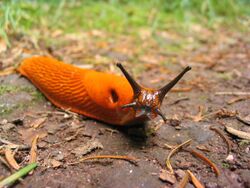Biology:Arion (gastropod)
| Arion | |
|---|---|

| |
| Arion rufus | |
| Scientific classification | |
| Domain: | Eukaryota |
| Kingdom: | Animalia |
| Phylum: | Mollusca |
| Class: | Gastropoda |
| Subclass: | Heterobranchia |
| Order: | Stylommatophora |
| Family: | Arionidae |
| Genus: | Arion A. Férussac, 1819[1] |
| Type species | |
| Arion empiricorum A. Férussac, 1819
| |
Arion is a genus of air-breathing land slugs in the family Arionidae, the roundback slugs. Most species of this Palearctic genus are native to the Iberian Peninsula.[2]
Species can be difficult to distinguish from one another upon cursory examination, because individuals of a species can vary in color and there are few obvious differences between taxa.[3] The color of an individual can be influenced by its diet.[4]
Some Arion are known as pests, such as A. lusitanicus auct. non Mabille (= A. vulgaris), which damages agricultural crops and ornamental plants, and A. rufus, a familiar garden pest.[5] Arion slugs are often transported internationally in shipments of plant products and mushrooms.[6] Arion slugs have been identified in North America and Australia as invasive species, altering the plants of ecosystems through seed predation and competing with native slugs.[7]
Species
There are approximately 40 species in the genus.[4][8]
Species include:
- Arion ater (Linnaeus, 1758) – black slug
- Arion circumscriptus Johnston, 1828 – brown-banded arion
- Arion distinctus Mabille, 1868 – darkface arion
- Arion fasciatus (Nilsson, 1823) – orange-banded arion
- Arion flagellus Collinge, 1893
- Arion fuscus (O.F.Müller, 1774)
- Arion hortensis Férussac, 1819 – small striped slug
- Arion intermedius Normand, 1852 (syn. Arion alpinus Pollonera, 1887[9]) – hedgehog slug
- Arion lusitanicus Mabille, 1868
- Arion obesoductus (syn. Arion alpinus auctt. non Pollonera, 1887[9])
- Arion occultus R.Anderson, 2004
- Arion owenii Davies, 1979 – warty arion
- Arion rufus (Linnaeus, 1758) – red slug
- Arion silvaticus Lohmander, 1937 – forest arion
- Arion simrothi Künkel, 1909
- Arion subfuscus (Draparnaud, 1805) – dusky arion
- Arion transsylvanus Simroth, 1885[10]
- Arion vulgaris Moquin-Tandon, 1855 (syn. Arion lusitanicus auct. non Mabille) – Spanish slug
Also included
- Arion vejdorskyi, a taxon with unclear taxonomic position
Etymology
The name Arion is from Neo-Latin, from the Greek areíones, a “kind of snail or slug.”[11]
References
- ↑ Férussac, A. E. and G. Deshayes. 1819–1851. Histoire naturelle générale et particulière des mollusques terrestres et fluviatiles, tant des espèces que l'on trouve aujourd'hui vivantes, que des dépouilles fossiles de celles qui n'existent plus; classés d'après les caractères essentiels que présentent ces animaux et leurs coquilles. pp. Tome 1: 8 + 184 pp.; Tome 2 (1): 402 pp.; 2 (2): 260 + 22 + 16 pp.; Atlas 1: 70 pl.; Atlas 2: 166 + 5 pl.. Paris. (J.-B. Bailliere).
- ↑ Quinteiro, J., et al. (2005). Phylogeny of slug species of the genus Arion: evidence of monophyly of Iberian endemics and of the existence of relict species in Pyrenean refuges. Journal of Zoological Systematics and Evolutionary Research 43(2), 139-48.
- ↑ Skujienė, G. and M. Soroka. (2003). A comparison of different DNA extraction methods for slugs (Mollusca: Pulmonata). Ekologija 1, 12-16.
- ↑ 4.0 4.1 Jordaens, K., et al. (2001). Food-induced body pigmentation questions the taxonomic value of colour in the self-fertilizing slug Carinarion spp.[|permanent dead link|dead link}}] Journal of Molluscan Studies 67(2), 161-67.
- ↑ Soroka, M., et al. (2008). Distribution and genetic diversity of the terrestrial slugs Arion lusitanicus Mabille, 1868 and Arion rufus (Linnaeus, 1758) in Poland based on mitochondrial DNA. Folia Biologica 57(1-2), 1-2.
- ↑ Barr, N. B., et al. (2009). Application of a DNA barcode using the 16S rRNA gene to diagnose pest Arion species in the USA. Journal of Molluscan Studies 75(2), 187-91.
- ↑ Zemanova, Miriam; Broenniman, Olivier; Guisan, Antoine; Knop, Eva; Heckel, Gerard (13 June 2018). "Slimy invasion: Climatic niche and current and future biogeography of Arion slug invaders". Diversity and Distributions: A Journal of Conservation Biogeography 24 (11). https://onlinelibrary.wiley.com/doi/10.1111/ddi.12789. Retrieved 12 July 2020.
- ↑ "Arion". Integrated Taxonomic Information System. https://www.itis.gov/servlet/SingleRpt/SingleRpt?search_topic=TSN&search_value=77070.
- ↑ 9.0 9.1 Manganelli, G., et al. (2010). The status of Arion alpinus Pollonera 1887, and re-description of Arion obesoductus Reischütz 1973 (Gastropoda, Arionidae). Journal of Conchology 40, 269-76.
- ↑ Jordaens, K., et al. (2010). Arion transsylvanus (Mollusca, Pulmonata, Arionidae): rediscovery of a cryptic species. Zoologica Scripta 39(4), 343-62. doi:10.1111/j.1463-6409.2010.00425.x.
- ↑ "Definition of ARION" (in en). https://www.merriam-webster.com/dictionary/Arion.
Wikidata ☰ Q83625 entry
 |

